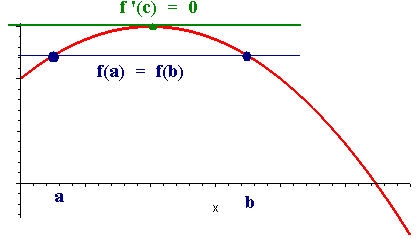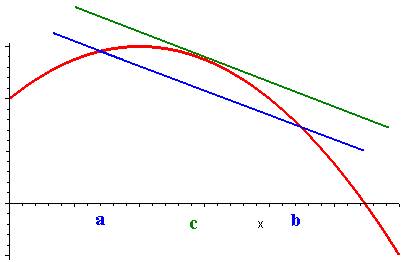Derivative Theorems
Rolle's Theorem
Rolle's theorem says that if a ball is thrown up and comes back down,
then at some time along its journey it is neither going up or down, i.e., it
reaches a maximum. Formally it says...
Let
f(x)
be differentiable on
[a,b]
with then there is a c with f '(c) = 0
|

Proof:
Since f(x) has a max and a min, one of the max or min
must not be an endpoint.
Hence
f '(c) = 0 for some
c.
The Mean Value Theorem
The mean value theorem states that the instantaneous velocity
equals the average velocity somewhere along the trip.
| The Mean Value Theorem Let f be a continuous function on [a,b] and differentiable on (a,b), then there exists a number c in (a,b) such that
f(b) - f(a)
|
In other words there is a point c such that f
'(c) equals the slope of the secant
from a to b.

Example:
Suppose that at 10:00 you are spotted by a police officer
near the Y, and that at 10:05 you are spotted in Myers
(5 miles from the
Y). The second officer claims that somewhere you must have been traveling
exactly 60 miles per hour. Is the officer's claim justified?
Solution:
Let 10:00 correspond to t = 0 and the Y correspond to
s =
0 then a = 0, b =
1/12, f(a) = 0 and f(b) =
5, so there is a c between a
and b (some time between 10:00
and 10:05) such that
5 - 0
f '(c) =
= 60
1/12 - 0
Therefore the officer's claims are valid.
The Intermediate Value Theorem
The intermediate value theorem says that if you trace a
continuous curve with your starting point f(a) units above the
x-axis and
your ending point f(b) units above the x-axis, then your pencil will draw
points at all heights between f(a) and f(b).
|
The Intermediate Value Theorem
If f is continuous on
[a,b]
and |
Corollary If f(a) and f(b) have different signs, then
f has a root between
a and b.
Example
Show that the polynomial
y = x7 - 2x6
+ 3x4 + x3 - 4x - 10
Has a root on the interval [0,2]
Solution
We have
y(0) = -10
and
y(2) = 38
since
-10 < 0 < 38
and since y(x) is a polynomial, in particular continuous, the intermediate
value theorem tells us that y(c) = 0 for some value of
c between 0 and 2.
The Extreme Value Theorem
The extreme value theorem tell us that all continuous function
reach a top and a bottom.
|
If f is continuous on [a,b] then
|
e-mail Questions and Suggestions